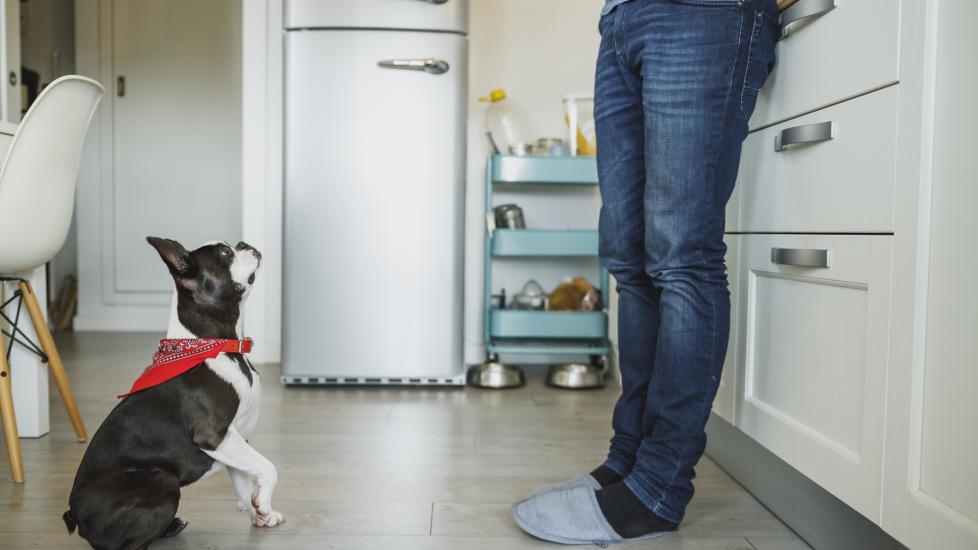Can Dogs Eat Kale?
Your pooch is probably more likely to want a bite of chicken than that leafy green stuff in your salad, but an adventurous eater may want to try a bite of your kale. Healthy adult dogs can eat a small amount of kale every once in a while, similar to its cruciferous cousins like romaine, spinach, and iceberg lettuce.
As long as it’s shared as an occasional treat, kale is OK for dogs to eat. Pet parents who want to increase their dog’s fiber intake may opt to incorporate a pinch of these leafy greens as a food topper as part of a balanced diet.
But there are a few precautions to take when sharing kale with your dog. Dogs with kidney issues or G.I. sensitivities should avoid kale. The amount of kale matters as well, since feeding too much or too often can cause an upset stomach.
Here’s what to know about how to safely feed your dog kale, and when you should call your vet for advice.
Is Kale Good for Dogs?
As a “superfood,” kale packs a number of nutrients into those dark green leaves. Kale is full of antioxidants, vitamins A, B, C, and K, plus minerals like potassium and calcium. It’s considered one of the most nutritious greens (compared to its leafy cousins like arugula or watercress).
But, similar to lettuce, kale is mostly made up of water and fiber and is low in calories and protein. Because dogs require a balanced, nutrient-dense diet, kale should only be given to healthy adult dogs as an occasional supplement to their regular food. Kale should never be considered a substitute for the nutrients dogs need from a well-balanced dog food.
If your dog is on a weight loss diet, incorporating kale (or other low-calorie veggies like cucumbers) to their bowl may help them lose weight, if your veterinarian recommends it. This is because leafy greens like kale are mostly water, so a few bites of this fiber-rich, crunchy plant can help them feel full for longer while eating less.
Kale should never be considered a substitute for the nutrients dogs need from a well-balanced dog food.
Just be sure not to overfeed kale to your pup—start with a very small amount, and only offer as an occasional treat or food topper.
Can Kale Be Bad for Dogs?
Keep in mind that not all dogs should eat kale, especially if they have kidney issues or other digestive sensitivities. Do not share kale with dogs who have kidney or bladder issues. Kale is a source of calcium oxalate, and too much in their diet could lead to kidney or bladder stones.
As with any new food, talk to your vet about whether kale is a safe addition to your dog’s diet, especially if they have a health condition or are prone to digestive issues. Like other fibrous foods, kale can cause an upset stomach or diarrhea.
How To Prepare Kale for Dogs
Thoroughly wash the kale to remove pesticides, chemicals, and any contaminants lthat may be present. Raw, uncooked kale is fine for dogs to eat, but steaming or blanching it may make it easier for them to digest.
Remove the stems, chop into small pieces, and add a small amount of plain cooked or raw kale to their regular food dish for a boost of fiber and nutrients.
Avoid other ingredients (like salad dressing or seasonings) that could be harmful. Many salad dressings contain garlic or onions, which are toxic for dogs.
How Much Kale Can a Dog Eat?
If your vet says it’s OK, start with a very small amount of kale and see how your dog’s digestive system reacts to this new fiber-forward ingredient. While this leafy green can be a healthy addition to your dog’s dish, too much fiber can cause gastrointestinal issues like constipation, flatulence, or diarrhea.
Watch for any adverse reactions to the kale before offering it again. Don’t give your dog any more kale if your pup experiences digestive issues or discomfort.
Here are some general guidelines for how much kale is safe for dogs to eat, based on their weight:
-
Extra-small dog (2–20 pounds) = 1/2 teaspoon of washed, chopped kale per week
-
Examples: Yorkies, Chihuahuas, Pomeranians, Pugs
-
-
Small dog (21–30 pounds) = About 1 teaspoon (or less) of washed, chopped kale per week
-
Examples: Basenjis, Beagles, Scottish Terriers
-
-
Medium dogs (31–50 pounds): About 2 teaspoons (or less) of washed, chopped kale per week
-
Examples: Basset Hounds, Border Collies, Australian Cattle Dogs
-
-
Large dogs (51–90 pounds): About 1 tablespoon (or less) of washed, chopped kale per week
-
Examples: Pit Bulls, German Shepherds, Labrador Retrievers, Australian Shepherds
-
-
Extra-large dogs (over 90 pounds): 2 tablespoons (or less) of washed, chopped kale per week
-
Examples: Newfoundlands, Bernese Mountain Dogs, Saint Bernards, Great Pyrenees
-
Other Salad Greens Dogs Can Eat
There are plenty of other leafy greens that are safe for dogs to eat. Just be sure to only feed in small amounts and as an occasional treat—moderation is key!
Keep in mind that these are just general guidelines. It’s always best to check with your vet before making changes to your dog’s diet.
Featured Image: Getty/MonikaBatich
